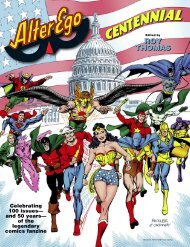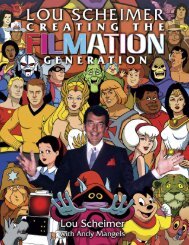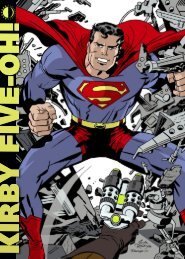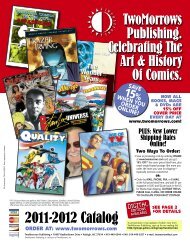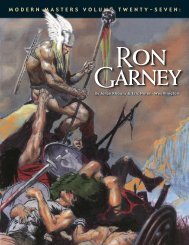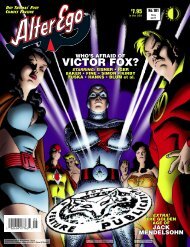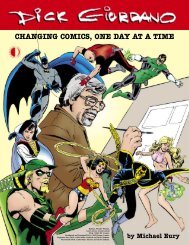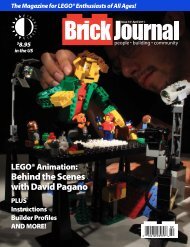JENETTE KAHN - TwoMorrows Publishing Store
JENETTE KAHN - TwoMorrows Publishing Store
JENETTE KAHN - TwoMorrows Publishing Store
You also want an ePaper? Increase the reach of your titles
YUMPU automatically turns print PDFs into web optimized ePapers that Google loves.
y A n d y M a n g e l s<br />
Iconographic<br />
Makeover<br />
Legendary designer<br />
Milton Glaser’s<br />
“WW” insignia was<br />
incorporated into this<br />
sleek new logo by<br />
letterer supreme<br />
Todd Klein in 1981.<br />
Courtesy of<br />
Andy Mangels.<br />
TM & © DC Comics.<br />
The planet’s most famous superheroine has been closely<br />
tied to many ideals since her inception. A golden eagle<br />
had adorned Wonder Woman’s chest since her debut in<br />
All Star Comics #8 (Dec. 1941), and her star-spangled<br />
costume was known worldwide thanks to comics,<br />
licensing, a popular TV series, and animated appearances<br />
on Super Friends. Wonder Woman’s costume had gone<br />
through a few minor redesigns over the decades—and<br />
she had forsaken her traditional look entirely for a<br />
few years—but a major change was about to hit the<br />
Amazing Amazon for her 40th birthday in 1982. Her<br />
iconic emblem was going to be replaced by a new,<br />
clearly licensable logo, and at the same time, be used<br />
as the symbol for a new foundation dedicated to<br />
recognizing important women of the 20th century!<br />
The new Wonder Woman costume design appeared<br />
first in press materials sent out by DC to comics fanzines<br />
such as The Comics Reader and Amazing Heroes (July 1981).<br />
A piece of Style Guide art came with the information,<br />
with penciler Jose Delbo and inker Dick Giordano<br />
illustrating what the new costume’s bodice would look<br />
like in action. At the time, DC was clear that its purposes<br />
were to create an emblem for Wonder Woman that<br />
would be a strong licensing component in the same style<br />
as the Superman “S” shield and the Batman oval chest<br />
symbol. The press info also revealed that the costume<br />
change would take place in a 16-page insert comic<br />
within DC Comics Presents #41, which would also<br />
showcase the new creative team of writer Roy Thomas,<br />
penciler Gene Colan (recently defected from Marvel),<br />
and inker Romeo Tanghal, under editor Len Wein.<br />
The costume would appear in the Amazing Amazon’s<br />
own title beginning with Wonder Woman #288.<br />
The newly designed bodice was originally going to<br />
be given to Wonder Woman as part of a “battle trophy<br />
or promotion,” according to an article in Comics Feature<br />
#12/13 (Sept.–Oct. 1981). On the bodice and the book’s<br />
logo was a stylized “double W” symbol, which still<br />
slightly resembled an eagle, but was also clearly an icon.<br />
Letterer Todd Klein recalled on his online blog<br />
(http://kleinletters.com) that Milton Glaser designed<br />
the new icon (though whether he personally designed<br />
it or if it was someone in his large studio is in question).<br />
Klein himself then redesigned the Wonder Woman<br />
comic-book logo, incorporating the Glaser symbol. “I tried<br />
to emulate the classic simplicity of the emblem with<br />
classic block letters running out from the two W[’]s, and<br />
added a wing tip to the N to help tie it together,” Klein<br />
wrote. Because this new logo obscured part of the new<br />
icon design, a secondary logo was designed for licensing—<br />
probably by Glaser’s studio—and used as part of DC’s<br />
new Style Guide and on later issues of the comic.<br />
Echoing comments from Gene Colan (in an interview<br />
in BACK ISSUE #41), past DC editor and writer Andrew<br />
Helfer recalls that Glaser’s redesign of the logo was a<br />
difficulty for artists to utilize initially, especially “how<br />
difficult it was to make the damn thing wrap around<br />
the character’s ‘bodice.’ I recall it was delivered ‘flat’<br />
by Glaser—just another bullet-style logo to him—and<br />
the stacked Ws were uniformly hated by artists and<br />
editors, none of whom could figure out how it worked<br />
(look at some of the early appearances to see the<br />
results).” Helfer recalls today that it may have been<br />
“Ernie Colón, working with Joe Orlando, [who] finally<br />
figured out how it worked.”<br />
ANNOUNCING THE FOUNDATION<br />
By October 1981, the comics press was reporting even<br />
more interesting news: As part of Wonder Woman’s<br />
40th anniversary year, DC had hired Karen Lippert,<br />
the former director of special projects at Ms. Magazine,<br />
to coordinate a series of celebratory activities. Planned<br />
were a film festival, a TV special, and the debut<br />
of the Wonder Woman Foundation. The nonprofit<br />
organization, as press materials promised, was created,<br />
“expressly to advance principles of equality for women<br />
in American society.”<br />
4 8 • B A C K I S S U E • J e n e t t e K a h n I s s u e



